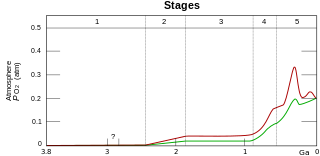Related Research Articles

An obligate aerobe is an organism that requires oxygen to grow. Through cellular respiration, these organisms use oxygen to metabolise substances, like sugars or fats, to obtain energy. In this type of respiration, oxygen serves as the terminal electron acceptor for the electron transport chain. Aerobic respiration has the advantage of yielding more energy than fermentation or anaerobic respiration, but obligate aerobes are subject to high levels of oxidative stress.

An aerobic organism or aerobe is an organism that can survive and grow in an oxygenated environment. In contrast, an anaerobic organism (anaerobe) is any organism that does not require oxygen for growth. Some anaerobes react negatively or even die if oxygen is present. The ability to exhibit aerobic respiration may yield benefits to the aerobic organism, as aerobic respiration yields more energy than anaerobic respiration. In July 2020, marine biologists reported that aerobic microorganisms (mainly), in "quasi-suspended animation", were found in organically-poor sediments, up to 101.5 million years old, 250 feet below the seafloor in the South Pacific Gyre (SPG), and could be the longest-living life forms ever found.
An anaerobic organism or anaerobe is any organism that does not require molecular oxygen for growth. It may react negatively or even die if free oxygen is present. In contrast, an aerobic organism (aerobe) is an organism that requires an oxygenated environment. Anaerobes may be unicellular or multicellular. Most fungi are obligate aerobes, requiring oxygen to survive. However, some species, such as the Chytridiomycota that reside in the rumen of cattle, are obligate anaerobes; for these species, anaerobic respiration is used because oxygen will disrupt their metabolism or kill them. Deep waters of the ocean are a common anoxic environment.
Primary nutritional groups are groups of organisms, divided in relation to the nutrition mode according to the sources of energy and carbon, needed for living, growth and reproduction. The sources of energy can be light or chemical compounds; the sources of carbon can be of organic or inorganic origin.

Cellular respiration is the process by which biological fuels are oxidised in the presence of an inorganic electron acceptor such as oxygen to produce large amounts of energy, to drive the bulk production of ATP. Cellular respiration may be described as a set of metabolic reactions and processes that take place in the cells of organisms to convert chemical energy from nutrients into adenosine triphosphate (ATP), and then release waste products.

Lactic acid fermentation is a metabolic process by which glucose or other six-carbon sugars are converted into cellular energy and the metabolite lactate, which is lactic acid in solution. It is an anaerobic fermentation reaction that occurs in some bacteria and animal cells, such as muscle cells.
A mesophile is an organism that grows best in moderate temperature, neither too hot nor too cold, with an optimum growth range from 20 to 45 °C. The optimum growth temperature for these organisms is 37°C. The term is mainly applied to microorganisms. Organisms that prefer extreme environments are known as extremophiles. Mesophiles have diverse classifications, belonging to two domains: Bacteria, Archaea, and to kingdom Fungi of domain Eucarya. Mesophiles belonging to the domain Bacteria can either be gram-positive or gram-negative. Oxygen requirements for mesophiles can be aerobic or anaerobic. There are three basic shapes of mesophiles: coccus, bacillus, and spiral.
Anaerobic respiration is respiration using electron acceptors other than molecular oxygen (O2). Although oxygen is not the final electron acceptor, the process still uses a respiratory electron transport chain.

A facultative anaerobic organism is an organism that makes ATP by aerobic respiration if oxygen is present, but is capable of switching to fermentation if oxygen is absent.

Obligate anaerobes are microorganisms killed by normal atmospheric concentrations of oxygen (20.95% O2). Oxygen tolerance varies between species, with some species capable of surviving in up to 8% oxygen, while others lose viability in environments with an oxygen concentration greater than 0.5%.

A microaerophile is a microorganism that requires environments containing lower levels of dioxygen than that are present in the atmosphere (i.e. < 21% O2; typically 2–10% O2) for optimal growth. A more restrictive interpretation requires the microorganism to be obligate in this requirement. Many microaerophiles are also capnophiles, requiring an elevated concentration of carbon dioxide (e.g. 10% CO2 in the case of Campylobacter species).

Fermentation is a metabolic process that produces chemical changes in organic substrates through the action of enzymes. In biochemistry, it is narrowly defined as the extraction of energy from carbohydrates in the absence of oxygen. In food production, it may more broadly refer to any process in which the activity of microorganisms brings about a desirable change to a foodstuff or beverage. The science of fermentation is known as zymology.
The Pasteur effect describes how available oxygen inhibits ethanol fermentation, driving yeast to switch toward aerobic respiration for increased generation of the energy carrier adenosine triphosphate (ATP).
The Crabtree effect, named after the English biochemist Herbert Grace Crabtree, describes the phenomenon whereby the yeast, Saccharomyces cerevisiae, produces ethanol (alcohol) in aerobic conditions at high external glucose concentrations rather than producing biomass via the tricarboxylic acid (TCA) cycle, the usual process occurring aerobically in most yeasts e.g. Kluyveromyces spp. This phenomenon is observed in most species of the Saccharomyces, Schizosaccharomyces, Debaryomyces, Brettanomyces, Torulopsis, Nematospora, and Nadsonia genera. Increasing concentrations of glucose accelerates glycolysis which results in the production of appreciable amounts of ATP through substrate-level phosphorylation. This reduces the need of oxidative phosphorylation done by the TCA cycle via the electron transport chain and therefore decreases oxygen consumption. The phenomenon is believed to have evolved as a competition mechanism around the time when the first fruits on Earth fell from the trees. The Crabtree effect works by repressing respiration by the fermentation pathway, dependent on the substrate.
Cellular waste products are formed as a by-product of cellular respiration, a series of processes and reactions that generate energy for the cell, in the form of ATP. One example of cellular respiration creating cellular waste products are aerobic respiration and anaerobic respiration.

A microbial mat is a multi-layered sheet of microorganisms, mainly bacteria and archaea, or bacteria alone. Microbial mats grow at interfaces between different types of material, mostly on submerged or moist surfaces, but a few survive in deserts. A few are found as endosymbionts of animals.

Ecosystem respiration is the sum of all respiration occurring by the living organisms in a specific ecosystem. The two main processes that contribute to ecosystem respiration are photosynthesis and cellular respiration. Photosynthesis uses carbon-dioxide and water, in the presence of sunlight to produce glucose and oxygen whereas cellular respiration uses glucose and oxygen to produce carbon-dioxide, water, and energy. The coordination of inputs and outputs of these two processes creates a completely interconnected system, constituting the underlying functioning of the ecosystems overall respiration.

Before photosynthesis evolved, Earth's atmosphere had no free oxygen (O2). Small quantities of oxygen were released by geological and biological processes, but did not build up in the atmosphere due to reactions with reducing minerals.
Aerobic denitrification or co-respiration the simultaneous use of both oxygen (O2) and nitrate (NO3−) as oxidizing agents, performed by various genera of microorganisms. This process differs from anaerobic denitrification not only in its insensitivity to the presence of oxygen, but also in that it has a higher potential to create the harmful byproduct nitrous oxide.
Aerobic fermentation or aerobic glycolysis is a metabolic process by which cells metabolize sugars via fermentation in the presence of oxygen and occurs through the repression of normal respiratory metabolism. It is referred to as the Crabtree effect in yeast. and is part of the Warburg effect in tumor cells. While aerobic fermentation does not produce adenosine triphosphate (ATP) in high yield, it allows proliferating cells to convert nutrients such as glucose and glutamine more efficiently into biomass by avoiding unnecessary catabolic oxidation of such nutrients into carbon dioxide, preserving carbon-carbon bonds and promoting anabolism.
References
- ↑ Engelhardt, W. A. (1974). "On the dual role of respiration". Molecular and Cellular Biochemistry. 5 (1): 25–33. doi:10.1007/BF01874169. PMID 4372523. S2CID 40991988.
- ↑ Rutten, MG (1970). "The history of atmospheric oxygen". Origins of Life and Evolution of Biospheres. 2 (1): 5–17. Bibcode:1970SLSci...2....5R. doi:10.1007/BF00928950. PMID 5521892. S2CID 21984448.
- ↑ Berkner, L. V.; Marshall, L. C. (1965). "History of major atmospheric components". Proceedings of the National Academy of Sciences. 53 (6): 1215–1226. doi: 10.1073/pnas.53.6.1215 . ISSN 0027-8424.
- ↑ Berkner, L. V.; Marshall, L. C. (1 May 1965). "On the origin and rise of oxygen concentration in the Earth's Atmosphere". Journal of the Atmospheric Sciences. 22 (3): 225–261. doi:10.1175/1520-0469(1965)022<0225:OTOARO>2.0.CO;2.
- ↑ Berkner, L. V. & Marshall, L. C. (1965). Oxygen and evolution. New Scientist, 28, 415-9.
- ↑ Berkner, L. V.; Marshall, L. C. (1987), "Oxygen, evolution in atmosphere", Climatology, Dordrecht: Kluwer Academic Publishers, pp. 644–656, doi:10.1007/0-387-30749-4_130, ISBN 978-0-87933-009-5 , retrieved 2022-10-07